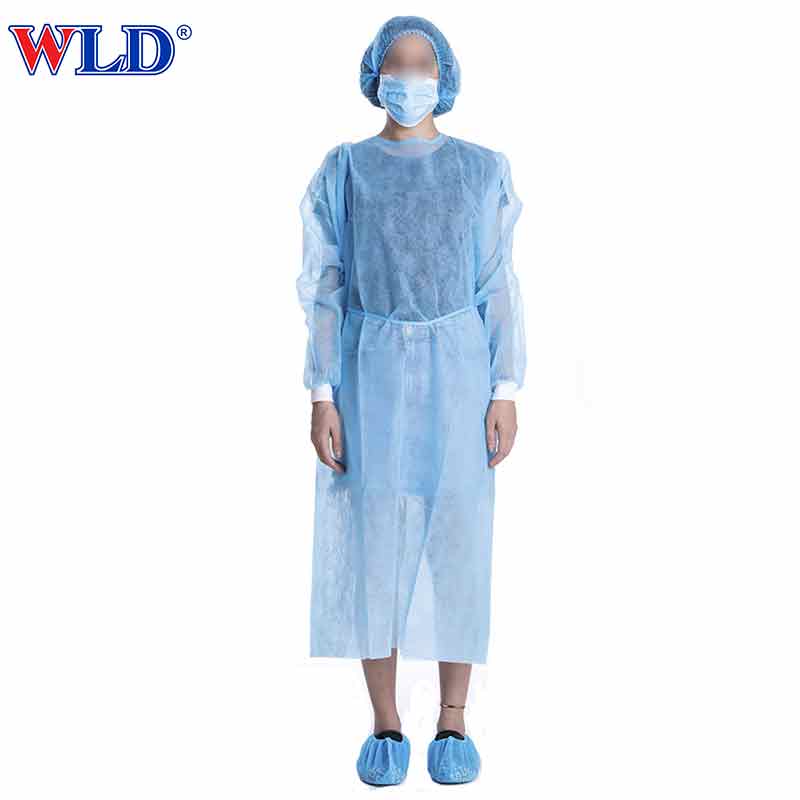
AAMI Surgical Gown
|
Item |
AAMI Surgical Gown |
|
Material
|
1. PP/SPP(100% Polypropylene Spunbond Nonwoven Fabric) |
|
2. SMS (Polypropylene Spunbond Nonwoven Fabric + Meltblown Nonwoven fabric + Polypropylene Spunbond Nonwoven Fabric) |
|
|
3. PP+PE Film4. Microporous 5.Spunlace |
|
|
Size |
S(110*130cm), M(115*137cm), L(120*140cm) XL(125*150cm) or any other customized sizes |
|
Gram |
20-80gsm is available( as your request) |
|
Feature |
Eco-Friendly, Anti-alcohol, Anti-Blood, Anti-Oil, Waterproof,Acid proof, Alkali proof |
|
Application |
Medical & health / Household / Laboratory |
|
Color |
white/blue/green/yellow/red |
Description
Surgical gowns are personal protective equipment used by many people in health care. Surgical gowns are used by surgeons and the surgical team for all types of procedures. Modern surgical gowns provide a breathable, protective barrier for the surgeons and all health care providers.
Surgical gowns provide a barrier protection to prevent blood strikethrough and fluid contamination. Most surgical gowns are sterile and come in a wide variety of sizes and versions. Surgical gowns can be purchased alone or within surgical packs. There are many surgical packs for frequently performed procedures.
Surgical gowns are produced non-reinforced or reinforced. Non-reinforced surgical gowns are less durable and designed for surgical procedures with low to moderate fluid contact. Reinforced surgical gowns have reinforced protection in specific critical areas for more invasive and intense surgical procedures.
Surgical gowns cover and provide a barrier for important areas from the shoulders to the knees and wrists. Surgical gowns are usually made with Set-In sleeves or Raglan Sleeves. Surgical gowns come with and without a towel.
Most surgical gowns are made from a fabric called SMS. SMS stands for Spunbond Meltblown Spunbond. SMS is a lightweight and comfortable non-woven fabric that provides a protective barrier.
Surgical gowns are usually rated by their AAMI level. AAMI is the Association of the Advancement of Medical Instrumentation. AAMI was formed in 1967 and they are a primary source of many medical standards. AAMI has four protection levels for surgical gowns, surgical masks, and other protective medical equipment.
Level 1: is used for Minimal Risk of exposure situations, such as providing basic care and cover gowns for visitors.
Level 2: is used for Low Risk of exposure situations, such as during common blood drawing procedures and suturing.
Level 3: is used for Moderate Risk of exposure situations, such as surgical procedures and inserting an Intravenous (IV) line.
Level 4: is used for High Risk of exposure situations, such as during long, fluid intense surgical procedures.
Features
1. Surgical clothes sewing by ultrasonic technology without needle holes, ensuring surgical clothes bacteria resistance and water impermeability.
2. Reinforced surgical clothes adds a surgical clothes and two sleeve stickers on the basis of standard chest paste, which enhances the barrier performance of surgical clothes (high-risk parts) to bacteria and liquid.
3. Threaded cuffs: comfortable to wear, and the doctor does not slip when wearing gloves.
4. Transfer card: instrument nurses and tour nurses do not need holding pliers, and directly transfer.
Advantages of AAMI Surgical Gown
1.SMMS Fabric:Disposable breathable soft able and strong adsorption ablitity,The high-quality surgical gown which is sterilized provide reliable and selective blood or any other liquid.
2.Rear collar velcro:The real collar velcro design can adjust the paste paste length according to the actual needs,which is conve-nient to use,firm and not easy to slide off.
3.Elastic knit ribbed cuffs:Elastic knit ribbed cuffs,moderate elasticity,easy to put on and take off.
4.Waist lace up:Double layer lace up design inside and outside the waist,tighten the waist,fit the body,and wear more flexible and comfortable.
5.Ultrasonic seam:The fabric splicing place adopts ultrasonic seam treatment,which has good sealing and strong firmness.
6.Packaging:We use packaging for our surgical gown.the characteristic of this kind of packaging that it allows bacteria to get out of the package but not to enter the package.









